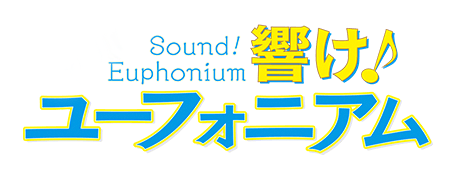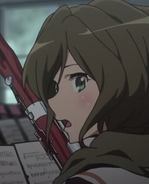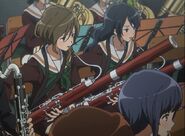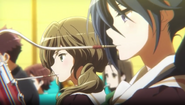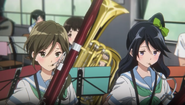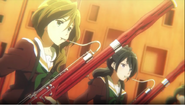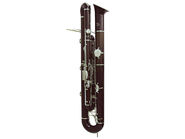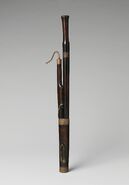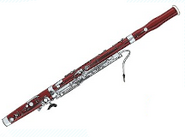The Bassoon (ファゴット Fagotto) is an instrument in the woodwind family. A musician who plays the bassoon is called a bassoonist or bassoon player.
Construction[]
A bassoon is mostly made out of wood. It is divided into the bell, the bass (long) joint, the tenor (wing) joint, and the boot joint. In additional, there is a silver crook (bocal) containing the instrument's double reed, usually made out of bamboo, which is the part the player blows into.
Variants[]
Contrabassoon[]
The contrabassoon is the lowest-pitched woodwind instrument in common use. Pitched one octave lower than the bassoon, it is a transposing instrument, with music notated an octave higher than sounding. The instrument is known for its distinct reedy, dark tone, as well as its unique paperclip shape.
Contraforte[]
The contraforte is a modern variant of the contrabassoon. It has an improved dynamic range and a less harsh tone compared to the regular contrabassoon. The most striking physical difference is its upturned bell, in contrast to the normal downwards bell on contrabassoons. It has gained popularity in recent years, with many new bassoonists preferring to play contraforte over contrabassoon like Lewis Lipnick.
Tenoroon[]
The tenoroon is essentially a pocket sized bassoon, and, as its name suggests, is the tenor member of the bassoon family, pitched in F, or very rarely, in G However, it is very rare and therefore not called for often in musical literature.
Performance[]
To make a sound on the bassoon, the player blows into the double reed attached to the instrument's bocal. A bassoon typically requires a lot of breath to make it sound good, the same amount of breath that an oboist needs.
The player will open and close the silver keys, which will change the pitch of the instrument, as on other woodwind instruments. Bassoons, perhaps infamously, are known for requiring a lot of thumb work in regards to pressing keys.
Like oboists, most bassoonists did not start on their own instrument. Just as an oboist usually learns a year or two of clarinet or flute before switching to oboe, a bassoonist has typically played oboe or clarinet for a year or two before switching to bassoon.
Scoring[]
Bassoons are used primarily in concert bands, symphony orchestras, and wind quintets. Like oboes, they are never used in marching bands, for a variety of reasons. Instead, other instruments like saxophones, and historically sarrusophones, fill in their role. Bassoonists will normally become color guard members or double on another instrument during marching season.
The bassoon is known for its distinctive tone color, wide range, variety of character and agility. Listeners often compare its warm, dark, reedy timbre to that of a male baritone voice.
As such, bassoons usually function as a bass role in ensembles. However, many pieces, especially orchestral, feature bassoon solos.
In some concert bands, the bassoons are their own separate section from the oboes, but in other bands, the bassoons and oboes are combined in one “double reeds” section, which is what the Kitauji High School Concert Band does.
As portrayed in Sound! Euphonium[]
There are two bassoon players in the Kitauji High School Concert Band:
- Raina Kitamura - Principal Bassoon, Double Reeds Section Leader
- Mikino Oka - Bassoon
In Sound! Euphonium: The Movie - Our Promise: A Brand New Day, two new bassoonists join the ensemble:
- Eru Kabutodani - Bassoon
- Suruga Koteyama - Contrabassoon
In Rikka High School Marching Band, there is a bassoonist named Momoka Koyama.
Together with the oboes, they form the double reed section.
Trivia[]
- Bassoonists are typically stereotyped as being lonely, incompetent at their instrument, and generally dimwitted. However, Raina Kitamura completely defies their stereotype with her graceful playing during her solo in Crescent Moon Dance and her good representation of her section at section leader meetings.
- Both Raina and Mikino were among the first to react to Reina Kousaka's superior playing during her trumpet audition, implying the pair's good musical talent awareness.
- Bassoons seen in Sound! Euphonium are probably based on Yamaha YFG-811 or YFG-812 model.
Gallery[]
| Musical instruments in Sound! Euphonium | |
|---|---|
| Woodwinds | |
| Brass | |
| Strings | |
| Percussion | |
| Other | |
